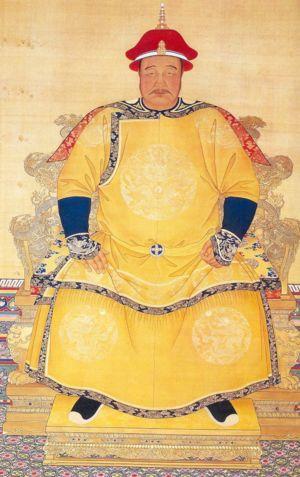
Hong Taiji
| Name | Hong Taiji |
| Title | 1st emperor of the Qing Dynasty (1592-1643) |
| Gender | Male |
| Birthday | 1592-11-28 |
| nationality | Qing dynasty |
| Source | https://www.wikidata.org/wiki/Q296367 |
| pptrace | View Family Tree |
| LastUpdate | 2025-10-27T03:41:06.438Z |
Introduction
Hong Taiji (28 November 1592 – 21 September 1643), also known as Huang Taiji and sometimes referred to as Abahai in Western literature, was a prominent figure in early Qing history. He held the title of second khan of the Later Jin dynasty and became the founding emperor of the Qing dynasty. His reign is marked by significant consolidation of the empire established by his father, Nurhaci, and the laying of groundwork for the subsequent conquest of the Ming dynasty, a goal he died before fully achieving.
Family and Names:
Hong Taiji was the eighth son of Nurhaci, the founder of the Later Jin. He may have had Mongolian ancestry and was possibly related through the Yehe Nara clan to the Mongolic Daur people, as a member of the Aisin-Gioro clan. The personal name "Hong Taiji" is derived from the Manchu rendition of the Mongolian title Khong Tayiji, itself borrowed from the Chinese term huang taizi (“crown prince”). There is scholarly debate whether "Hong Taiji" was his personal name or a title; evidence from archival documents suggests it was likely his given name, not a title.
In Manchu sources, personal names of emperors were taboo, and Hong Taiji was typically referred to as the "Fourth Beile," indicating his rank among Nurhaci's sons. Western scholars earlier referred to him as "Abahai," a name now considered mistaken, possibly originating from misinterpretation or confusion with his era name or other titles.
Titles and Posthumous Honors:
Hong Taiji claimed the title Great Khan as Bogd Sécén Khaan, referred to as Bogda Khan by Mongol subjects. His reign era names include Tiancong (1627–1636) and Chongde (1636–1643). Posthumously, his temple name was Taizong, the customary designation for a second emperor in a dynasty. His posthumous name, "Wen Huangdi," translates to "the culturing emperor."
Political and Military Career:
Ascending the throne after Nurhaci's death in 1626, Hong Taiji initially controlled the two White Banners but later shifted control to the Yellow Banners, which he held along with the elite Plain Yellow and Bordered Yellow Banners. His governance was characterized by efforts to consolidate power, including the suppression of rivals. He was known for his diplomatic skills, military prowess, and policies promoting ethnic integration, such as recruiting Han Chinese officials and arranging mass marriages between Han officers and Manchu women to foster harmony.
Expansion and Conquests:
Hong Taiji expanded the Later Jin territory across Manchuria, capturing Inner Mongolia and launching raids into Mongolian regions and Korea. He attempted to invade Ming China and, after defeats in initial campaigns, invested heavily in artillery and cavalry. In 1636, he invaded Korea, which surrendered in 1637 and became tributary. He also secured the Mongolian Plateau through a series of military campaigns, completing the conquest of the Amur region by 1644.
Name Changes and Dynasty Establishment:
In 1635, Hong Taiji renamed his people from Jurchen to Manchu, a move aimed at fostering a distinct national identity. The following year, he formally declared the establishment of the Qing dynasty, replacing the name Later Jin. The choice of "Qing," meaning "clear" or "pure," was possibly influenced by Taoist symbolism and was intended to signal a new beginning, as well as to mitigate internal conflicts among his brothers.
Government and Policies:
Hong Taiji adopted a governmental structure modeled on Ming institutions, including the Six Ministries and the Censorate, and incorporated Han Chinese officials into his administration. He also established the Mongol Yamen for governance of Inner Mongolia. His policies reflected a pragmatic approach to ethnic diversity, utilizing military, political, and cultural means to strengthen the Qing state.
Death and Succession:
Hong Taiji died on 21 September 1643, shortly before Qing forces captured Beijing. His death precipitated a succession crisis that was temporarily resolved by crowning his five-year-old son, Fulin, as the Shunzhi Emperor, with Dorgon acting as regent. His body was interred at Zhaoling in northern Shenyang.
Legacy:
Historians often regard Hong Taiji as a capable and strategic ruler whose policies and military campaigns significantly advanced the Qing state’s position. Some scholars consider him the first effective emperor of the Qing dynasty due to his foundational reforms and expansion efforts, citing his political acumen and military skills comparable to renowned emperors and leaders in Chinese and Mongolian history.
Family Tree
Tap to expand more relatives
Parents
Children
- State Princess Wenzhuang
- Lobohoi
- Bombogor
- Ninth Daughter Of Huang Taiji
- State Princess Yong'an
- Šose
- Gose
- Shunzhi Emperor
- Thirteenth Daughter Of Huang Taiji
- State Princess Duanshun
- State Princess Shuhui
- Qangxu
- Sixth Daughter Of Huang Taiji
- Toose
- State Princess Aukhan
- Tenth Daughter Of Huang Taiji
- Twelfth Daughter Of Huang Taiji
- State Princess Shuzhe
- Yebušu
- Loge
- State Princess Yongmu
- Hooge
- Princess Of The Second Rank Kechun
- State Princess Jingduan